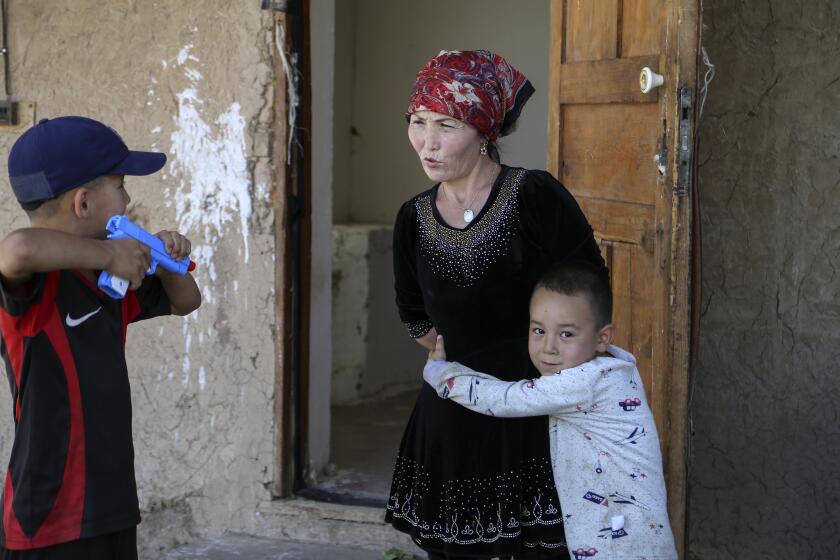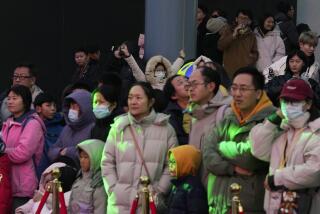China says its population grew in 2020 despite report of possible decline

- Share via
BEIJING — China’s population grew last year, the government said Thursday, following a report that a census might have found a surprise decline, possibly adding to downward pressure on economic growth.
The National Bureau of Statistics gave no details in its one-sentence statement and said the population figure would be reported later. But the unusual decision to respond to a report by the Financial Times reflected the issue’s political sensitivity.
The Financial Times said people familiar with China’s 2020 census expect it to show that the population, which edged above 1.4 billion in 2019, declined for the first time since a government-caused famine in 1959-61 killed millions of people.
The ruling Communist Party has enforced birth limits to restrain population growth since 1980, but an outright fall would reduce the flow of workers into the economy when it is trying to shore up growth and reduce poverty.
“According to our understanding, in 2020, China’s population continued to grow,” the NBS said on its website.
China’s population has long been expected to peak and decline in line with trends in South Korea and other developing Asian economies. But researchers say China’s decline might start before it reaches their income levels.
Beijing says it has met its goal of wiping out extreme poverty in China by the end of 2020. The top-down effort has disrupted untold individual lives.
Developed economies such as Japan and Germany also are trying to figure out how to support aging populations with shrinking workforces. But they can draw on decades of investment in factories, technology and foreign assets, whereas China has less wealth, and its industries need young workers.
Researchers at the Chinese central bank argued in a report in March that the birth rate is lower than official estimates suggest, though they didn’t say total population had declined. To avert a labor shortage, they said, the government needs to make it easier and cheaper to raise children.
“Compared with developed countries, the demographic transition happened faster in our country, the transition period is shorter, and aging problems and sub-replacement fertility are severer,” the report said.
Already, China’s population of potential workers ages 15 to 59 has shrunk from its 2011 peak of 925 million, according to government data. The Ministry of Human Resources and Social Security said in 2016 that the group might shrink to 700 million by 2050.
A state-orchestrated campaign is reducing births among the minority Uighurs of China’s far west Xinjiang region with brutal efficiency.
China’s population rose by 4.7 million people in 2019 to just above 1.4 billion, according to government data. That was growth of just 0.3%.
“If China’s population is peaking already, that may not change much about the outlook this decade, but it could have major economic implications further ahead,” Mark Williams, chief Asia economist for Capital Economics, said in a report.
The International Monetary Fund is forecasting Chinese economic growth of 8.4% this year following a rebound from the COVID-19 pandemic. The ruling Communist Party says it wants to double output per person from 2020 levels by 2035, which would require annual growth of about 4.7%.
China is on track to be overtaken by India before 2025 as the world’s most populous country.
Start your day right
Sign up for Essential California for the L.A. Times biggest news, features and recommendations in your inbox six days a week.
You may occasionally receive promotional content from the Los Angeles Times.
China still has a bigger workforce, but India’s forecast total of just over 1 billion workers in 2035 will be 120 million more than China’s, the central bank report said. It said India’s lead would swell to 270 million workers by 2050.
The Chinese government is making changes, but it isn’t clear whether it can reverse a long-term decline in worker numbers and strain on an underfunded retirement system.
Beijing took its most dramatic step in 2015 when restrictions that limited many couples to one child were eased to allow two. The impact was modest: Many couples with one child had a second, but total births in 2017-18 declined because others had none.
More to Read
Sign up for Essential California
The most important California stories and recommendations in your inbox every morning.
You may occasionally receive promotional content from the Los Angeles Times.















